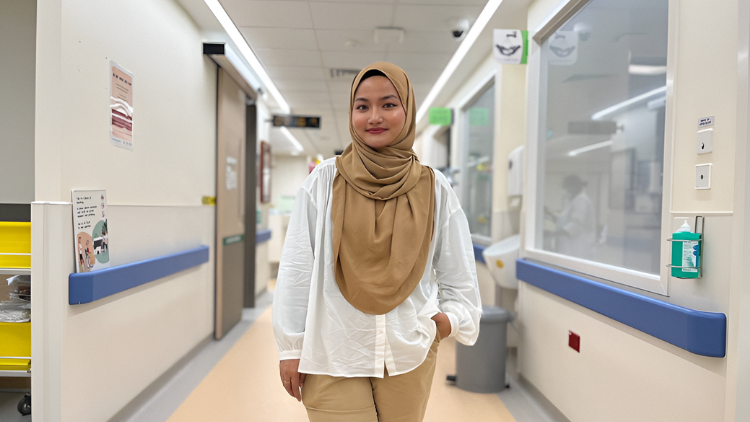
In our Behind the Scenes: HealthTech series, we shine the spotlight on the unsung heroes and heroines – the healthtechies – who work behind the spotlight, at times round the clock to keep Singapore’s healthcare IT systems running. Due to their nature of work, from deploying new tech and systems at healthcare facilities, to diagnosing issues, running urgent security patches and regular maintenance, their important contributions are often more felt than seen. Explore how our tech specialists ensure the health of tech, so that doctors, nurses and clinicians can focus on delivering high quality public healthcare for their patients.
“I hope to be more confident about myself and not underestimate my abilities,” shares Karina Rizfia, describing a personal aspiration as she grows into a new polyclinic project as an Assistant Systems Engineer.
A member of the End-User Computing (EUC) team in Synapxe’s Infrastructure Services department, Karina helps to ensure that end-users, such as healthcare professionals – including doctors and nurses – and administrators enjoy a seamless experience when using the various healthcare applications and IT equipment.
Working closely with the end-users, IT specialists and deployment engineers, Karina supports and coordinates the launch of the IT infrastructure and equipment, as well as new features and enhancements – sometimes through her weekends.
Having joined Synapxe as an intern, Karina is now a full-time staff who continues to thrive in her area of expertise. Read on to find out more about how Karina is committed to making a difference in HealthTech!

Surrounded by a sea of end-user computing devices, Karina stays on top of deployments.
What are your key responsibilities?
When there are IT requests relating to the set-up of new healthcare facilities or relocation of existing sites, the EUC team would be activated – to ensure that the healthcare facilities get equipped with sufficient hardware to support the systems that will be deployed.
Contrary to what outsiders may think, our role in IT infrastructure is not just about deploying PCs and monitors.
As part of the EUC team supporting the SingHealth cluster, some of my responsibilities include overseeing EUC projects from initiation to delivery and ensuring the efficient use of resources across the healthcare facilities.
At the project initiation stage, I coordinate the overall project timeline and work closely with the end users to evaluate the technical requirements and obtain and assess quotations for hardware equipment. As part of the planning, I would also perform risk management to enable the efficient use of resources – for example, when preparing for a new facility that would launch only in a few years’ time, we need to make sure the equipment we acquire are future-proof and has higher probability of being compatible with the systems of the future.
During the project delivery stage, I manage the set-up of hardware and devices, prepare for system readiness and provide support for the go-live or launch of new system features or enhancements. I also prepare user guides to support users on raising “tickets” whenever they face any technical issues or have new requests.
For the go-live activities, which are sometimes held on weekends, I need to ensure that the computers, monitors and printers are deployed correctly and resolve any on-ground issues.
Are users able to connect to the intranet and internet to access the healthcare systems? Are the printers able to print medical labels, certificates, and so on, from the integrated applications? These are some of the questions I keep at the top of my mind, as part of our go-live checklist. Any disruptions to the systems or equipment would affect the patient experience, resulting in situations such as longer waiting time at the wards or inaccessible medical records by clinicians.

